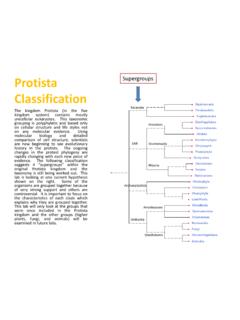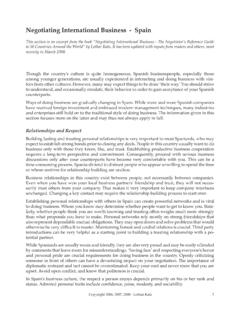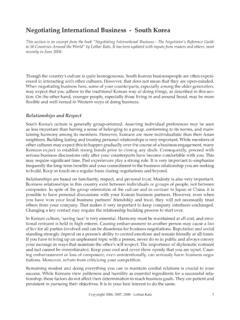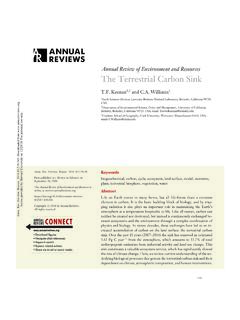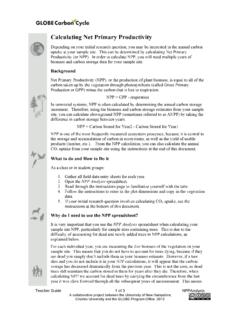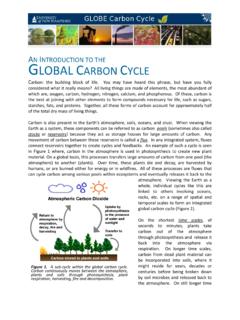Transcription of Protista Classification - Mt. San Antonio College
1 Protista Classification The kingdom Protista (in the five kingdom system) contains mostly unicellular eukaryotes. This taxonomic grouping is polyphyletic and based only on cellular structure and life styles not on any molecular evidence. Using molecular biology and detailed comparison of cell structure, scientists are now beginning to see evolutionary history in the protists. The ongoing changes in the protest phylogeny are rapidly changing with each new piece of evidence. The following Classification suggests 4 supergroups within the original Protista kingdom and the taxonomy is still being worked out.
2 This lab is looking at one current hypothesis shown on the right. Some of the organisms are grouped together because of very strong support and others are controversial. It is important to focus on the characteristics of each clade which explains why they are grouped together. This lab will only look at the groups that were once included in the Protista kingdom and the other groups (higher plants, fungi, and animals) will be examined in future labs. Excavata SAR Archaeplastida Unikonta Alveolates Stramenopila Rhizaria Amoebozoans Opisthokonts Protista Classification Starting with the four Supergroups , we will divide the rest into different levels called clades.
3 A Clade is defined as a group of biological taxa (as species) that includes all descendants of one common ancestor. Too simplify this process, we have included a cladogram we will be using throughout the course. We will divide or expand parts of the cladogram to emphasize evolutionary relationships. For the protists, we will divide the supergroups into smaller clades assigning them artificial numbers (clade1, clade2, clade3) to establish a grouping at a specific level. Excavata SAR Archaeplastida Unikonta Alveolates Stramenopila Rhizaria Amoebozoans Opisthokonts Classification : Domain: Eukarya Supergroup: Excavata Supergroup: Archaeplastida Clade2: Diplomonads Clade2: Rhodophyta Clade2: Parabasalids Clade2: Chlorophyta Clade2: Euglenozoans Clade2: Charophyta Clade3: Euglenids Supergroup: Unikonta Clade3: Kinetoplastids Clade1: Amoebozoans Supergroup: SAR Clade2: Slime Molds Clade1: Alveolates Clade3: Plasmodial Clade2.
4 Dinoflagellates Clade3: Cellular Clade2: Apicomplexans Clade2: Gymnamoebas Clade2: Ciliates Clade2: Entamoebas Clade1: Stramenopila Clade1: Opisthokonts Clade2: Bacillariophyta Clade2: Nucleariids Clade2: Chrysophyta Clade2: Choanoflagellates Clade2: Phaeophyta Clade2: Oomycetes Clade 1: Rhizaria Clade2: Cercozoans Clade2: Forams Clade2: Radiolarians Protista Classification Characteristics and structures These organisms once were placed in a single kingdom but with new genetic information, it now appears this kingdom is polyphyletic.
5 The individuals included in this new clade are all eukaryotes (with a nucleus and membrane-bound organelles) and most are single-celled. History The first protist (eukaryotic) organism appears in the fossil record about billion years ago during the Precambrian. It is believed the first protist was probably a non-pigmented heterotrophic form. It is believed that mitochondria and plastids were small prokaryotes that lived within other prokaryotes giving rise to new organelles. The serial endosymbiosis hypothesis suggests that mitochondria evolved before plastids through a series of endosymbiotic events.
6 The distribution of protists is worldwide; as a group, these organisms are both cosmopolitan and ubiquitous. Every individual species, however, has preferred niches and microhabitats, and all protists are to some degree sensitive to changes in their surroundings. The availability of sufficient nutrients and water, as well as sunlight for photosynthetic forms, is, however, the only major factors restraining successful and heavy protist colonization of practically any habitat on Earth. Supergroup: Excavata Characteristics and structures The members of this supergroup have similar cytoskeletal features and some members have an excavated groove on one side of their body.
7 History Each of the clades within the supergroup are monophyletic, but it is difficult to determine if this supergroup is monophyletic because the characteristics they have may have been found in the common ancestor of all eukaryotes. The Excavata includes taxa that are photosynthetic, parasitic, symbiotic and heterotrophic. The three clades are the Diplomanads, the Parabasalids and the Euglenozoans. Diagrammatic representations of the proximal cytoskeletons of Excavata Diplomonads ExcavataParabasalids Euglenozoans Supergroup: Excavata Clade2: Diplomonads Characteristics and structures The members of this clade have modified mitochondria called mitosomes.
8 They lack functional electron transport chains and cannot use oxygen to make ATP. They are anaerobic. They also have two equally sized haploid nuclei. Many Diplomonads are parasitic. Our Example is Giardia lamblia which parasitize the intestines of mammals. In California, It can be found in the highest streams in the Sierras. Characteristics - It can infect people when they drink contaminated water. It can cause cramps and severe diarrhea. Diplomonads ExcavataParabasalids Euglenozoans Supergroup: Excavata Clade2: Parabasalids Characteristics and structures The members of this clade have reduced mitochondria called hygrogenosomes.
9 They are anaerobic and release hydrogen peroxide as a by-product. They also have a modified flagella with an undulating membrane. Many parabasalids are parasitic. Our Example is Trichomonas vaginalis. Characteristics: It causes Vaginitis by infecting the vagina and urethral mucus membranes and can be transmitted by sexual intercourse. Males often have no symptoms when infected. Diplomonads ExcavataParabasalids Euglenozoans Supergroup: Excavata Clade2: Euglenozoans Characteristics and structures The members of this clade all have a rod with either a spiral or a crystalline structure inside each of their flagella.
10 They also have a disc-shaped cristae. The members of this clade are very diverse including predators, heterotrophs, photosynthetic autotrophs and parasites. The two best known groups are in the clades: Kinetoplastids and Euglenids. KinetoplastidsEuglenozoansEuglenidsDinof lagellatesDiplomonads ExcavataParabasalids Euglenozoans Supergroup: Excavata Clade2: Euglenozoans Clade3: Kinetoplastids Characteristics and structures The members of this clade have a single, large mitochondrion that contains a large mass of DNA called a kinetoplast.


